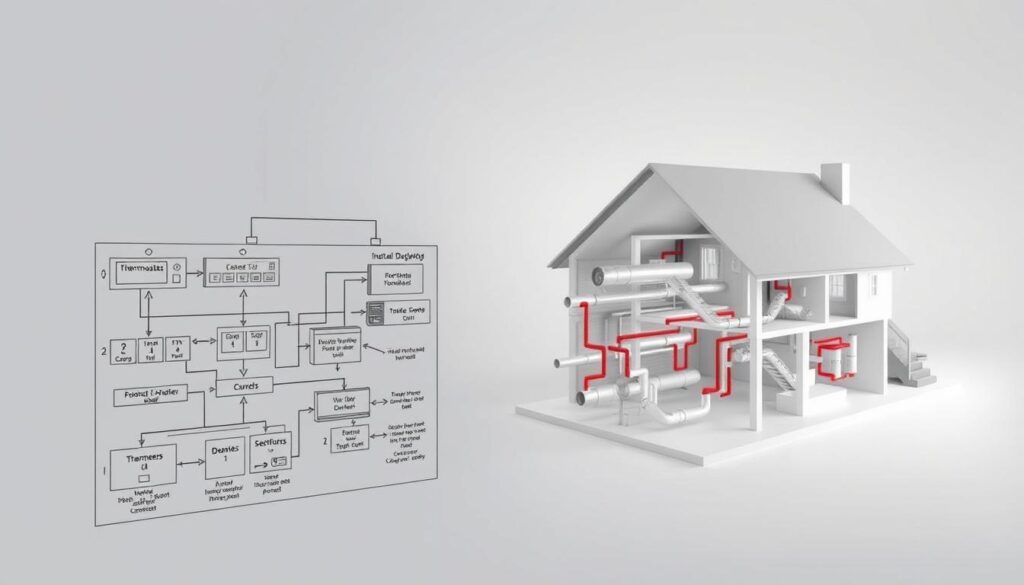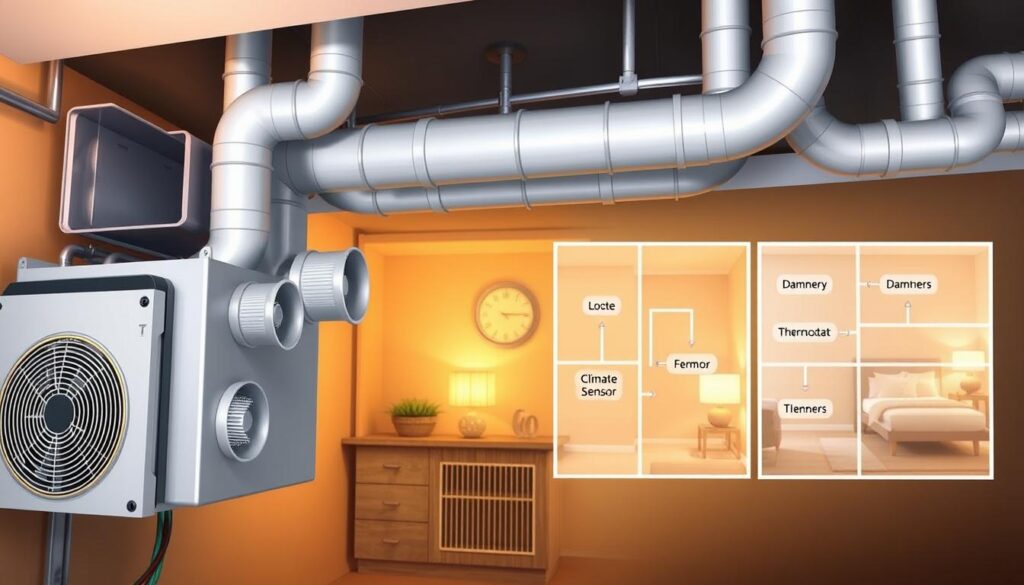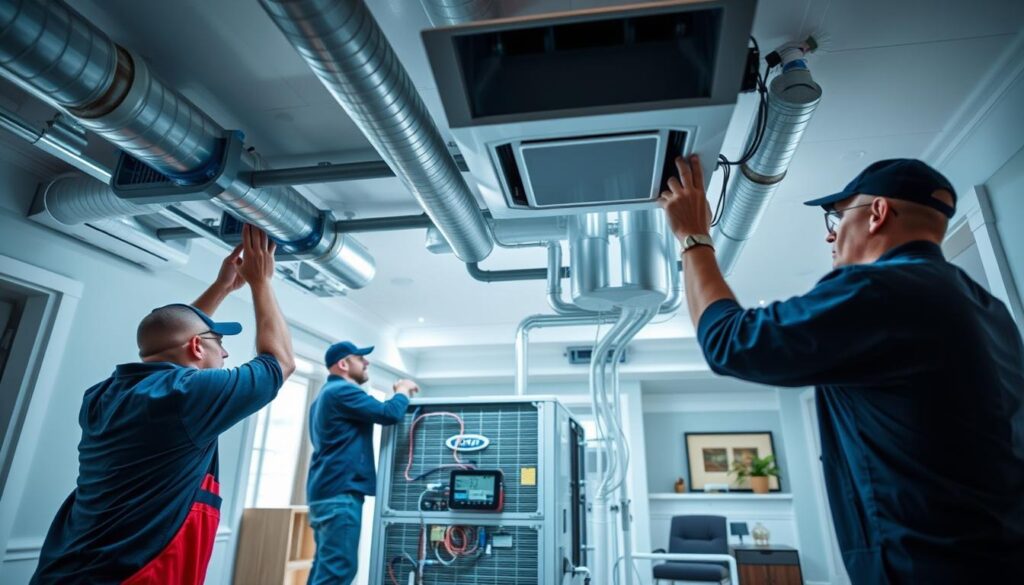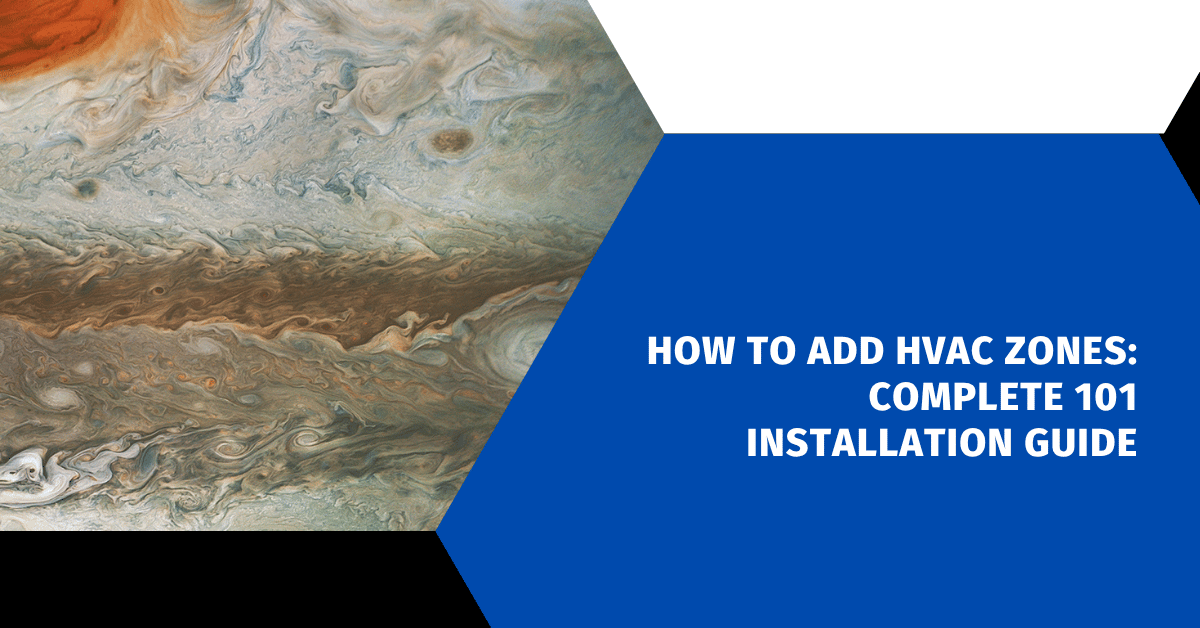Affiliate Disclosure
HVAC Guide Guys is a participant in the Amazon Services LLC Associates Program, an affiliate advertising program designed to provide a means for sites to earn advertising fees by advertising and linking to Amazon.
How to Add HVAC Zones? Are you tired of uneven temperatures in your home? Want to save energy and money? HVAC zoning might be what you need.

HVAC zoning lets you control your home’s temperature in different areas. It’s a smart way to avoid the hassle of uneven heating and cooling.
Adding HVAC zones can change how comfortable your home is. You’ll need to install dampers, smart controllers, and special thermostats. These work together to make your home more efficient and cozy.
Key Takeaways
- HVAC zoning provides customized temperature control for different home areas
- Reduces energy waste by heating and cooling only occupied spaces
- Improves overall home comfort and temperature consistency
- Can be retrofitted to existing HVAC systems
- Potential for significant long-term energy cost savings
Table of Contents
Understanding HVAC Zoning Systems
HVAC zone control is a smart way to manage your home’s climate. It makes heating and cooling more efficient and tailored to your needs. This is done by dividing your home into different areas with their own temperature settings.
Zoning lets you set the perfect temperature for each room. This means no more hot or cold spots. It also saves energy, making your home more comfortable.
What is HVAC Zoning?
HVAC zoning splits your home into separate climate zones. Instead of one temperature for the whole house, you can have different areas with their own settings.
- Customize temperature for individual rooms
- Reduce energy waste
- Improve overall home comfort
Components of a Zoned System
A complete hvac zone control system has several key parts:
| Component | Function |
|---|---|
| Zone Dampers | Control airflow to specific areas |
| Dedicated Thermostats | Manage individual zone temperatures |
| Control Panel | Coordinate damper and thermostat interactions |
Types of Zoning Systems
There are different hvac multi-zone systems for various homes:
- Forced-Air Zoning: Most common in residential settings
- Hydronic Zoning: Used with radiant heating systems
- Ductless Mini-Split Zoning: Ideal for homes without traditional ductwork
Knowing these options helps you choose the best system for your home’s layout and comfort needs.
Explore Our HVAC Shop
Looking for top-rated HVAC tools, parts, and accessories? Visit our shop and find the perfect solution for your needs.
Visit the ShopBenefits of Adding Zones to Your HVAC System
Adding zones to your HVAC system can change your home’s comfort and energy use. This smart method lets you set different temperatures in various areas. It makes your home feel just right for you.
Zoning your HVAC system brings many benefits. It’s more than just heating and cooling:
- Significant energy savings by targeting specific areas
- Reduced wear on HVAC equipment
- Enhanced individual room comfort
- Lower monthly utility bills
Your home has rooms with different needs. Bedrooms might be cooler, while living areas need warmth. HVAC thermostat zoning meets these needs by setting up custom zones.
| Zoning Benefit | Potential Savings |
|---|---|
| Energy Efficiency | Up to 30% on utility costs |
| Equipment Lifespan | Extended by 5-10 years |
| Comfort Control | Individual room management |
Choosing HVAC thermostat zoning makes your home smarter and more comfortable. You get exact temperature control, save on energy, and protect your HVAC system.
Essential Components for HVAC Zoning Installation
To make an HVAC zoning system work well, you need the right parts. These parts must work together to give you comfort in every room. Knowing what these parts are helps you make a system that saves energy and works better.
Pneumatic Dampers: Airflow Control Masters
HVAC dampers are key in zone control systems. They control the air flow in your ducts. This lets you set the temperature in each room just right. Pneumatic dampers open and close with compressed air, sending air where it’s needed.
- Control individual room temperatures
- Minimize energy waste
- Enhance overall system efficiency
Air Tubing and Manifold Systems: The Circulatory Network
HVAC zone valves and air tubing are the heart of your system. They link the dampers to the control system. This lets you manage air flow smoothly.
| Component | Function | Key Benefit |
|---|---|---|
| Air Tubing | Connects dampers to control system | Precise signal transmission |
| Manifold | Distributes compressed air | Consistent damper operation |
Smart Controllers and Thermostats: Intelligence in Climate Control
Today’s zoning systems use smart controllers and thermostats. These devices learn your habits and adjust the temperature for you. They also show you how much energy you use.
With these key parts, you can build a top-notch HVAC zoning system. It will make your home more comfortable and use less energy.
Explore Our HVAC Shop
Looking for top-rated HVAC tools, parts, and accessories? Visit our shop and find the perfect solution for your needs.
Visit the ShopHow to Add HVAC Zones to Existing Systems
Adding HVAC zones to your home can make it more comfortable and save energy. This upgrade lets you control temperatures in different areas without replacing your whole system.

Before starting, check if your current system can be updated. Not all systems can be changed easily, so getting a professional’s opinion is key.
- Check existing ductwork condition
- Evaluate current HVAC system’s age and capacity
- Determine number of desired temperature zones
- Inspect electrical and control system capabilities
For a successful upgrade, you’ll need:
- Zone dampers to control airflow
- Programmable zone control panel
- Additional thermostats for each zone
- Potential ductwork modifications
Professional HVAC technicians can guide you through the process. They’ll do a detailed analysis, suggest the right equipment, and ensure it’s installed correctly.
Proper planning and professional installation are essential for successful HVAC zoning retrofits.
While it’s harder than installing zones when you first build your home, the benefits are worth it. Homeowners often find it’s a good investment for better comfort and energy savings.
Variable Speed vs. Traditional HVAC Systems for Zoning
Homeowners have to choose between variable speed and traditional HVAC systems for multi-zone setups. Knowing the differences helps pick the best option for comfort and saving energy.
Traditional HVAC systems run at full power all the time. This can be a problem in multi-zone homes. They can’t adjust well to different temperature needs in each area.
Benefits of Variable Speed Equipment
- Precise temperature control in individual zones
- Reduced energy consumption
- Quieter operation
- Better humidity management
Variable speed systems are very flexible for multi-zone setups. They can adjust their power to match the exact heating or cooling needs of each zone.
Limitations of Traditional Systems
Single-stage systems have big challenges in zoned homes:
- They can’t adjust their power well
- They might wear out faster
- They use more energy
Cost Comparisons
Variable speed systems cost more at first. But they save money in the long run. Their energy efficiency and lower maintenance needs make up for the initial cost.
“Investing in a variable speed system is like buying a smart thermostat for your entire HVAC infrastructure.” – HVAC Professional
Your choice between traditional and variable speed systems depends on your home’s needs, budget, and comfort goals.
Explore Our HVAC Shop
Looking for top-rated HVAC tools, parts, and accessories? Visit our shop and find the perfect solution for your needs.
Visit the ShopStep-by-Step Installation Process

Installing HVAC zones needs careful planning and precision. When you learn how to add HVAC zones, follow a systematic approach. This ensures your home stays comfortable and efficient.
Start by assessing your home’s layout and ductwork. This step is key to figuring out the best zone setup.
- Measure and Map Ductwork
- Identify existing duct paths
- Determine potential zone boundaries
- Sketch a preliminary zone layout
- Prepare Installation Materials
- Gather pneumatic dampers
- Collect air tubing
- Verify smart control systems
- Install Zone Components
- Cut precise openings in ductwork
- Mount pneumatic dampers
- Connect air tubing systems
Professional tip: Precision is key when learning how to add HVAC zones. Improper installation can lead to inefficient temperature control and increased energy costs.
| Installation Step | Estimated Time | Complexity Level |
|---|---|---|
| Ductwork Assessment | 2-3 hours | Moderate |
| Damper Installation | 3-4 hours | High |
| Control System Setup | 1-2 hours | Low |
The last step is setting up your smart thermostats and testing each zone. While DIY is possible, getting help from an HVAC pro can make your installation more efficient. They know the best way to set up HVAC zones for your home.
Tools and Materials Required
Getting ready for an HVAC ductwork zoning project needs careful planning and the right tools. Whether you’re a pro or a DIY fan, you’ll need specific equipment and safety gear. This ensures your project goes smoothly and safely.
Essential Installation Equipment
Your HVAC zoning project needs precision and the right tools. Here are the key pieces you’ll need:
- Aviation snips for cutting sheet metal
- Adjustable wrench
- Drill/driver with multiple drill bit sizes
- Utility knife
- Tape measure
- Level
Safety Gear and Precautions
Safety is crucial during HVAC ductwork zoning installations. Protect yourself with these essential safety items:
- Safety glasses with side shields
- Work gloves
- Dust respirator
- Steel-toed boots
- Long-sleeve protective clothing
“Proper safety equipment is your first line of defense in any HVAC installation project.” – HVAC Professional
Specialized HVAC Tools
Professional HVAC zoning installations need specialized tools beyond basic ones:
- Digital multimeter
- Manometer for pressure testing
- Wire strippers
- Crimping tool
- Duct sealing tape
Investing in quality tools ensures a smoother, more efficient HVAC ductwork zoning installation process.
Cost Considerations and Budget Planning
When planning your HVAC new construction zoning budget, it’s important to think carefully about your finances. You can expect to spend between $1,500 and $8,500 for a full installation. This cost depends on several key factors.
Here are the main things that affect your HVAC zoning project’s cost:
- Home square footage
- Number of desired zones
- System complexity
- Equipment quality
- Labor rates in your region
When setting your budget for HVAC new construction zoning, remember to include different costs. Professional installation usually takes up 40-60% of the total cost. Smart thermostats and zone control systems can cost between $300 and $1,200. Dampers and extra equipment might add another $500 to $2,000.
Investing in a zoned HVAC system can potentially reduce energy costs by up to 30% compared to traditional heating and cooling approaches.
Your budget should balance the initial costs with long-term savings. Many homeowners see their investment pay off through lower utility bills in 3-5 years.
- Pro Tip: Get quotes from certified HVAC contractors
- Consider: Energy efficiency rebates and tax incentives
- Plan: Save 10-15% for unexpected costs
Good financial planning makes your HVAC new construction zoning project cost-effective and well-planned.
Explore Our HVAC Shop
Looking for top-rated HVAC tools, parts, and accessories? Visit our shop and find the perfect solution for your needs.
Visit the ShopMaintenance Requirements for Zoned Systems
Keeping your HVAC zone control system in top shape is key. Regular care ensures it works well, saves energy, and lasts longer. This is crucial for your zoned heating and cooling system.
Your zoned HVAC system needs special care to perform its best. Homeowners should pay attention to a few important areas. This helps protect their investment:
- Monthly air filter replacements
- Quarterly vent and register cleaning
- Biannual damper inspection
- Annual professional system tune-up
Important maintenance steps include checking pneumatic dampers for leaks. Small leaks can greatly reduce system efficiency. Smart controllers and thermostats need updates and battery checks for accurate temperature control.
Professional HVAC technicians suggest a detailed maintenance plan:
| Frequency | Maintenance Task |
|---|---|
| Monthly | Replace air filters |
| Quarterly | Clean air vents and registers |
| Annually | Professional system inspection |
By sticking to these maintenance tips, you’ll get the most out of your HVAC zone control system. You’ll also avoid unexpected breakdowns and save energy across your home.
Conclusion
Adding HVAC zones to your home can change how comfortable and energy-efficient it is. Learning how to add HVAC zones lets you control temperatures better. This process needs careful planning, expert help, and knowing your home’s heating and cooling needs.
Professional HVAC technicians are key to setting up zoning systems right. They look at your home’s layout and current HVAC setup. They suggest the best zoning plan for you. This can make your system work better and save you money on energy costs over time.
Your home’s comfort and energy use are linked. By learning about HVAC zones, you’re making your home more comfortable. Every home is different, so what works for one might not for another. Talking to a skilled HVAC pro will help you get a plan that fits your home perfectly.
Investing in HVAC zoning is a smart move for your home’s comfort and energy use. With the right setup, care, and expert advice, you can make your home comfortable for your family. It will also use energy wisely.

